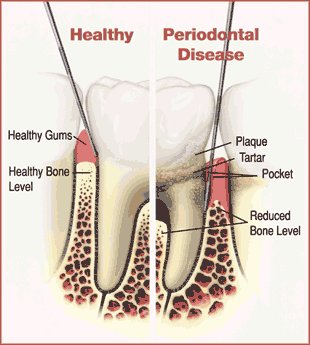in Los Angeles
Periodontal (gum) diseases, including gingivitis and periodontitis, are serious infections that, left untreated, can lead to tooth loss. The word periodontal literally means "around the tooth." Periodontal disease is a chronic bacterial infection that affects the gums and bone supporting the teeth.
Periodontal disease can affect one tooth or many teeth. It begins when the bacteria in plaque (the sticky, colorless film that constantly forms on your teeth) causes the gums to become inflamed.

In the mildest form of the disease, gingivitis, the gums redden, swell and bleed easily. There is usually little or no discomfort. Gingivitis is often caused by inadequate oral hygiene. Gingivitis is reversible with professional treatment and good oral home care.
Untreated gingivitis can advance to periodontitis. With time, plaque can spread and grow below the gum line. Toxins produced by the bacteria in plaque irritate the gums. The toxins stimulate a chronic inflammatory response in which the body in essence turns on itself, and the tissues and bone that support the teeth are broken down and destroyed. Gums separate from the teeth, forming pockets (spaces between the teeth and gums) that become infected. As the disease progresses, the pockets deepen and more gum tissue and bone are destroyed. Often, this destructive process has very mild symptoms. Eventually, teeth can become loose and may have to be removed.
Causes of Periodontal Disease
The main cause of periodontal disease is bacterial plaque, a sticky, colorless film that constantly forms on your teeth. However, factors like the following also affect the health of your gums.
- Smoking/Tobacco Use
- Genetics
- Pregnancy and Puberty
- Stress
- Medications
- Clenching or Grinding Your Teeth
- Diabetes
- Poor Nutrition
- Other Systemic Diseases
Periodontal Treatment
Following are some of the procedures that periodontists use to treat patients diagnosed with a periodontal (gum) disease. The main cause of periodontal disease is bacteria in the form of a sticky, colorless plaque that constantly forms on your teeth; however, many other factors can cause periodontal (gum) disease or influence its progression.
Non-Surgical Treatments
AAP treatment guidelines stress that periodontal health should be achieved in the least invasive and most cost-effective manner. This is often accomplished through non-surgical periodontal treatment, including scaling and root planing (a careful cleaning of the root surfaces to remove plaque and calculus [tartar] from deep periodontal pockets and to smooth the tooth root to remove bacterial toxins), followed by adjunctive therapy such as local delivery antimicrobials and host modulation, as needed on a case-by-case basis.
Most periodontists would agree that after scaling and root planing, many patients do not require any further active treatment, including surgical therapy. However, the majority of patients will require ongoing maintenance therapy to sustain health. Non-surgical therapy does have its limitations, however, and when it does not achieve periodontal health, surgery may be indicated to restore periodontal anatomy damaged by periodontal diseases and to facilitate oral hygiene practices.
Periodontal Surgery
If you're diagnosed with periodontal disease, your periodontist may recommend periodontal surgery. Periodontal surgery is necessary when your periodontist determines that the tissue around your teeth is unhealthy and cannot be repaired with non-surgical treatment. Following are the four types of surgical treatments most commonly prescribed:
- Pocket Reduction Procedures
- Regenerative Procedures
- Crown Lengthening
- Soft Tissue Grafts
Dental Implants
If you've already lost a tooth to periodontal disease or other reasons, you may be interested in dental implants – the permanent tooth replacement option.
Cosmetic Procedures
In addition to procedures to treat periodontal disease, many periodontists also perform cosmetic procedures to enhance your smile. Oftentimes, patients who pursue cosmetic procedures notice improved function as well. Cosmetic procedures include:
- Crown Lengthening
- Soft Tissue Grafts
- Ridge Augmentation
Ask us your smile consultation. We can evaluate your smile and provide a range of treatments available to help achieve the look you want.
